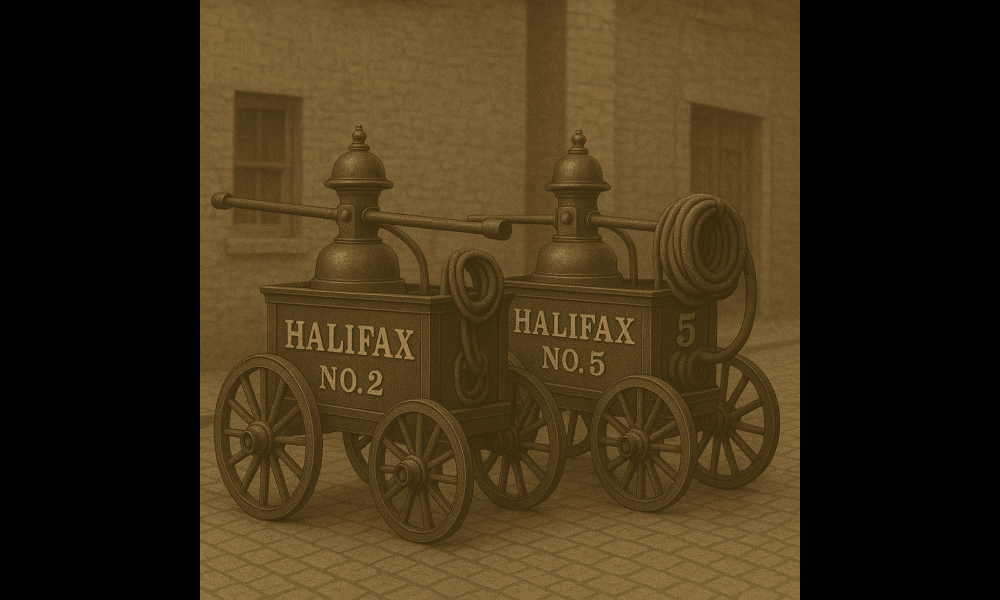In 1859, the City of Halifax purchased two new hand-pumped fire engines, a significant addition to the firefighting resources of the time. These acquisitions came during a period of heightened concern over the city's fire protection capabilities, particularly after the Granville Street Fire, also referred to as the “Great Fire” of 1859, which had underscored deficiencies in both equipment and organization.
Here are the documented details of the purchase:
-
The two new fire engines were hand-pumped models ordered from the United States, specifically from the firm W.E. Platt of New York, a company well-known at the time for producing quality firefighting equipment.
-
The order was placed on June 15, 1859, and the engines were designed to be lightweight and efficient for Halifax’s urban conditions.
-
Each engine cost the City approximately £210, making it a substantial but necessary investment in municipal safety.
-
Upon their arrival, the engines were distributed among existing engine companies. One was assigned to № 2 Division, housed at the Argyle Street Engine House, and the other to № 5 Division, operating from the Spring Garden Road Engine House.
The engines were praised for their performance, with records from the Union Engine Company indicating that they were put to use in actual firefighting operations within weeks of delivery. Their addition also prompted a reorganization of equipment assignments and helped improve confidence in the city’s fire protection services following recent devastating fires.
No mention was made of ceremonial events or public displays to mark their arrival, suggesting a practical focus on deployment rather than fanfare.
Fires Responded to by the 1859 Engines
Following their arrival in late summer 1859, the two new engines were immediately pressed into service. Historical records confirm their involvement in at least two major fire events that same year:
1. The Granville Street Fire (also called The Great Fire of 1859)
-
Date: October 11, 1859
-
Description: This was one of the most destructive fires Halifax had experienced up to that point. It began in a shop on Granville Street, rapidly spreading due to strong winds and the tightly packed wooden structures.
-
Destruction: Over 60 buildings were destroyed, including homes, businesses, and warehouses.
-
Engine Response:
-
One of the newly purchased hand-pumped engines (assigned to Division № 2) played a crucial role in helping prevent the fire from advancing further into the business district.
-
Reports from the time highlight the engine’s high reliability and sustained water stream, which was praised by both the firewards and citizen witnesses.
-
Despite the extensive loss, the effective deployment of this engine helped save adjacent blocks to the south and east.
-
2. Warehouse Fire near King's Wharf
-
Date: December 1859
-
Description: A fire broke out in a coal and timber warehouse at the southern end of the Halifax waterfront.
-
Response: The second new engine, assigned to Division № 5 at the Spring Garden Road station, was dispatched.
-
Effectiveness: While the warehouse was lost, the surrounding shipping facilities were spared due to the rapid and efficient response. The engine operated from a nearby tank, and this incident validated its capability for sustained operation in low-pressure water areas.
About the Manufacturer – W.E. Platt of New York
-
Company: W.E. Platt was a reputable fire engine manufacturer based in New York during the mid-19th century.
-
Specialty: The firm produced hand-pumped and early steam-powered fire engines. Their models were recognized for:
-
High-efficiency pump mechanisms
-
Durable frames
-
Lighter weight compared to older British models
-
-
Why Chosen by Halifax: The City Council selected Platt’s engines after consultation with engine companies and visiting engineers from Boston and New York. The Union Engine Company specifically recommended Platt, citing superior performance over previous British-made machines.
-
Legacy: Platt engines remained in service in Halifax for several years and were gradually replaced by steam engines in the early 1860s. The 1859 models remained in limited auxiliary use into the early 1870s.
Description of the 1859 Hand-Pumped Fire Engines
While no surviving models from Halifax are known today, the engines purchased from W.E. Platt of New York in 1859 would have resembled the mid-19th century “double-decker hand tubs”, as described in fire engineering records of the time.
Key Features:
-
Length: Approximately 8 to 10 feet
-
Weight: Around 2,000–2,400 pounds (without water)
-
Construction: Brass cylinder and pump housing; cast iron frame; wooden wheels
-
Pump Action: Manual double-piston mechanism powered by two long horizontal brakes (handles) on each side. Firefighters would rock the brakes up and down to drive the pump.
-
Water Stream: Capable of projecting water up to 120 feet under ideal conditions.
-
Capacity: Held a small onboard water reservoir (cistern), but primarily relied on drawing water from wells, cisterns, tanks, or fire plugs.
-
Hose: Typically connected to 2½-inch diameter hose lines; Halifax had 3-inch hose as of 1854, so likely required adapters or modifications.
Visual Style:
-
Painted in deep red or forest green with gilded trim and the Halifax city crest or engine division number on the side.
-
Large wrought-iron wheels, sometimes with leather-wrapped rims for traction.
-
The engines were pulled by firemen on foot, not horses, as Halifax was still in the pre-steam, pre-horse era for firefighting.
Impact on Fire Protection & the Formation of Volunteer Companies (1861) -
The 1859 engine purchases were intended to bolster a system already strained by outdated organization and increasing urban risk. However, the Granville Street Fire of 1859 laid bare the shortcomings of the system:
Deficiencies Revealed:
-
Even with new engines, the lack of manpower, coordination, and proper deployment protocols meant responses were inconsistent.
-
The Union and Axe Fire Companies were elite and exclusionary (Catholics and Irish were largely barred), leaving large portions of the public unengaged.
-
The Board of Firewards was seen as reactive and fragmented.
-
In some cases, neighborhoods were left vulnerable when engines were relocated or assigned without consultation.
The Push for Reform:
-
Citizens and some city officials began lobbying for a complete overhaul of Halifax’s fire service.
-
The performance of the new engines made it clear that better equipment alone wasn’t enough—a new organizational model was needed.
-
By late 1860, formal discussions were underway to dissolve the older system.
Outcome – Volunteer Companies Created (1861): -
In 1861, Halifax transitioned into the “Volunteer Era” with the founding of:
-
The Volunteer Engine Company (1861–1894)
-
The Volunteer Axe Company (1861–1896)
-
The Union Protection Company (1861–1919)
-
-
These new companies were more inclusive, better trained, and operated under improved municipal oversight.
-
The city eventually moved toward steam-powered engines and horse-drawn response over the following decade.


